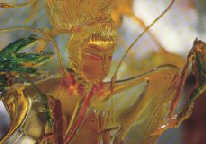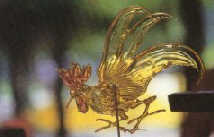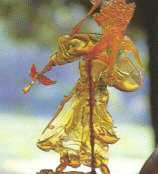
 As the name indicates, sugar painting refers to paintings done with sugar. Whether perceived as simply a bar of sugar or a piece of artwork, this art form is also very tasty. Sugar painting has gained widespread admiration from the common people.
As the name indicates, sugar painting refers to paintings done with sugar. Whether perceived as simply a bar of sugar or a piece of artwork, this art form is also very tasty. Sugar painting has gained widespread admiration from the common people.
The art of sugar painting is said to have been invented by Liu Bowen, the prime minister of the Ming Dynasty (1368-1644). As recorded in an ancient book of the Ming Dynasty, when people were offering sacrifices to the gods, they made sugar paintings depicting various animals and human figures - largely of civilian officials; hence, sugar painting was named "Sugar Prime Minister".
On the basis of traditional sugar painting techniques and deriving the characteristics and carving methods from the art of shadow puppetry, Sichuan folk artists further improved on the art of sugar painting. Following these innovations, moulds were no longer used and, instead, people used a little copper spoon to scoop out the sugar liquid and poured the liquid into various shadow picture molds. In this way, folk art "Sugar Shadows" came into being. By the time of the Qing Dynasty (1644-1911), sugar painting became more popular and the techniques became subtler.
 The most basic and only ingredient of sugar painting is malt dust. As a first step, the malt dust is melted into liquid, which is then scooped out with a little soup spoon and poured into different picture molds over the surface of a marble slate. When making sugar paintings one should pay great attention to the flowing speed and depth the sugar liquid. The painting should be done swiftly and deftly in case the liquid should curdle after the cooling process. Therefore, people who make sugar paintings must have a pair of sharp eyes and flexible hands.
The most basic and only ingredient of sugar painting is malt dust. As a first step, the malt dust is melted into liquid, which is then scooped out with a little soup spoon and poured into different picture molds over the surface of a marble slate. When making sugar paintings one should pay great attention to the flowing speed and depth the sugar liquid. The painting should be done swiftly and deftly in case the liquid should curdle after the cooling process. Therefore, people who make sugar paintings must have a pair of sharp eyes and flexible hands.
In modern times, sugar painting has taken on another form: It is sold immediately after it is made in a stall. The creator places the sugar into a copper spoon and heats it up until the sugar melts; then, he or she uses the spoon as a brush and the sugar liquid as ink. Using quick movements, an exquisite painting soon takes shape.
 There are different sources for inspiration in sugar painting, such as novels, opera figures, auspicious flowers and fruits, fowls and characters. Of all of these, figures and animals are most interesting. If it is a profile, the painting features lines; if it is a full face, the sugar is heaped over the head into the shape of a basso-relievo. Due to the fluidity of sugar, the paintings will not take on a similar shape even if they represent the same image. Having mastered this specialty, folk artists focus on lines when doing sugar paintings, thus creating a particular style which emits a sense of beauty.
There are different sources for inspiration in sugar painting, such as novels, opera figures, auspicious flowers and fruits, fowls and characters. Of all of these, figures and animals are most interesting. If it is a profile, the painting features lines; if it is a full face, the sugar is heaped over the head into the shape of a basso-relievo. Due to the fluidity of sugar, the paintings will not take on a similar shape even if they represent the same image. Having mastered this specialty, folk artists focus on lines when doing sugar paintings, thus creating a particular style which emits a sense of beauty.
With increasing exchanges between China and foreign countries, the art of sugar painting has frequently appeared at big cultural and tourist events. Sugar painting, though an inconspicuous folk art, is showing the world its unique charm.






















